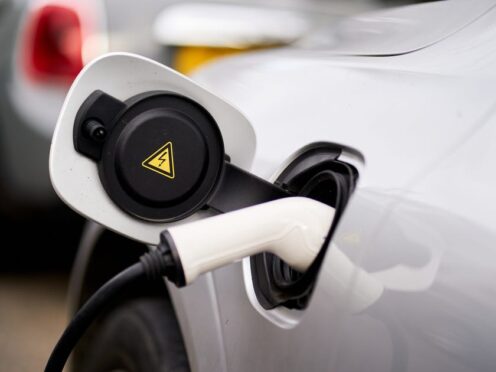
Car manufacturers will miss a key Government target for electric vehicle (EV) sales, MPs heard.
The share of the new car market held by pure battery electrics is predicted to be just 19.8% this year, industry body the Society of Motor Manufacturers and Traders (SMMT) told the Commons’ Transport Select Committee.
At least 22% of new cars and 10% of new vans sold by each manufacturer in the UK in 2024 is required to be zero-emission – which in most cases means pure electric – under the Government’s Zero Emission Vehicle (ZEV) mandate.
The threshold will rise annually until it reaches 100% by 2035.
SMMT head of technology and innovation David Wong told the committee the industry will not meet this year’s requirements as “we’re below that trajectory”.
He said: “Our members feel that the market will be – in terms of battery electric – cars 19.8% and vans 8.3%.
“So it’s below the 22% for cars and 10% for vans.”
Martin Sander, general manager of Ford’s electric car business, told the Financial Times Future of the Car summit earlier this month that the company could be forced to restrict sales of petrol cars in the UK to artificially boost the proportion of EV purchases.
Under the rules of the mandate, manufacturers risk being required to pay the Government £15,000 per polluting vehicle sold above the limits.
But ministers do not expect any businesses to face fines this year, as they will be able to use flexibilities such as purchasing credits from rival companies.
Quentin Willson, automotive journalist and founder of EV campaign group FairCharge, said: “We need to give people a reason to buy these cars.”
He called for “inexpensive incentives” for owning an EV, such as free parking and being able to use bus lanes.
Mr Willson warned that “misinformation” is “really putting people off” from buying an EV.
He said: “These cars are reliable, they don’t catch fire, the batteries don’t fail, they work.
“People are driving them happily.”
Speaking after the session, Steve Gooding, director of motoring research charity the RAC Foundation, said: “Whether it’s buying or running an electric car, cost is clearly a key issue, but the mood music from Whitehall suggests there will be no more public money to ease buyers into the market.
“That leaves manufacturers with the task of pitching their products at the right price to drive sales and meet their obligations under the ZEV mandate.
“Drivers want faff-free motoring and that’s clearly still a work in progress when it comes to running and recharging EVs.
“Industry and Government need to tackle the negative perceptions, and quickly, if the ultimate goal of greening road transport is to be achieved at a rapid pace.”
The SMMT said in a statement: “Manufacturers have invested billions to meet the UK’s ambitious targets with ever more of the latest, greenest models coming to market, however, decarbonisation ultimately depends on buyer demand.
“The most effective approach to transforming the market, therefore, is for Government to introduce smarter fiscal incentives on electric vehicle purchases and public charging, to support private consumers, not just corporate customers.”

Enjoy the convenience of having The Sunday Post delivered as a digital ePaper straight to your smartphone, tablet or computer.
Subscribe for only £5.49 a month and enjoy all the benefits of the printed paper as a digital replica.
Subscribe